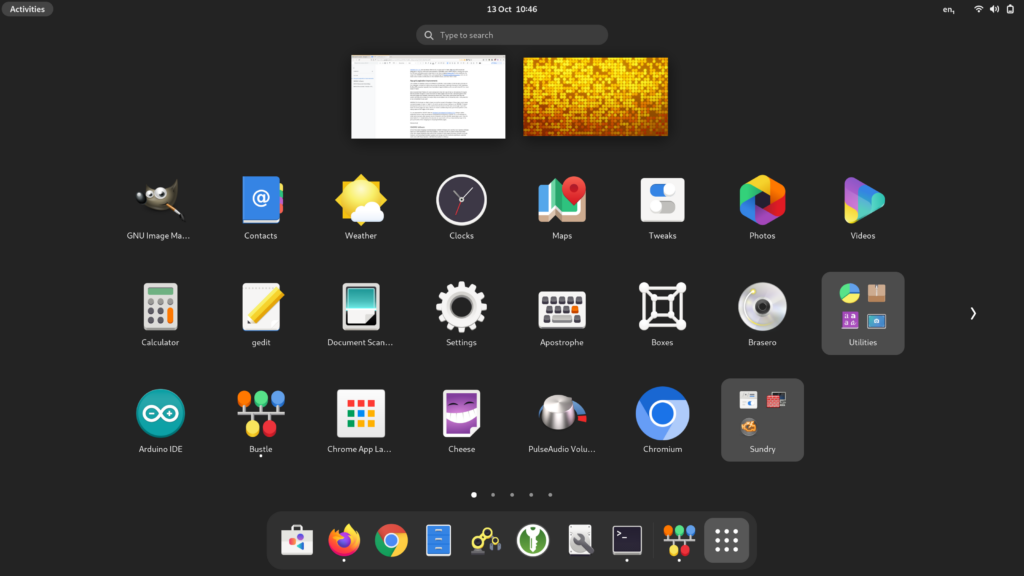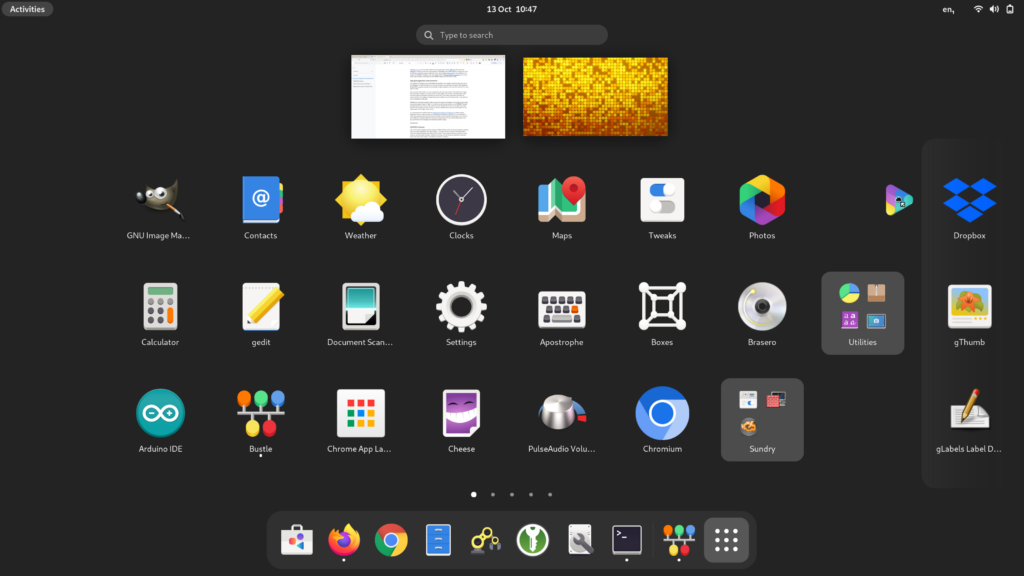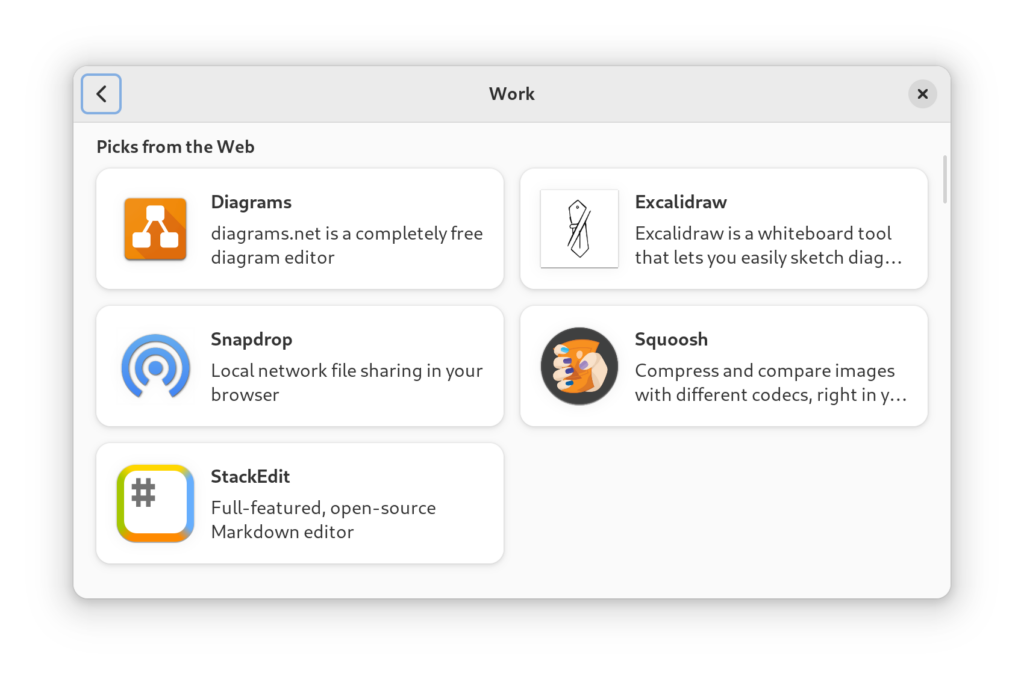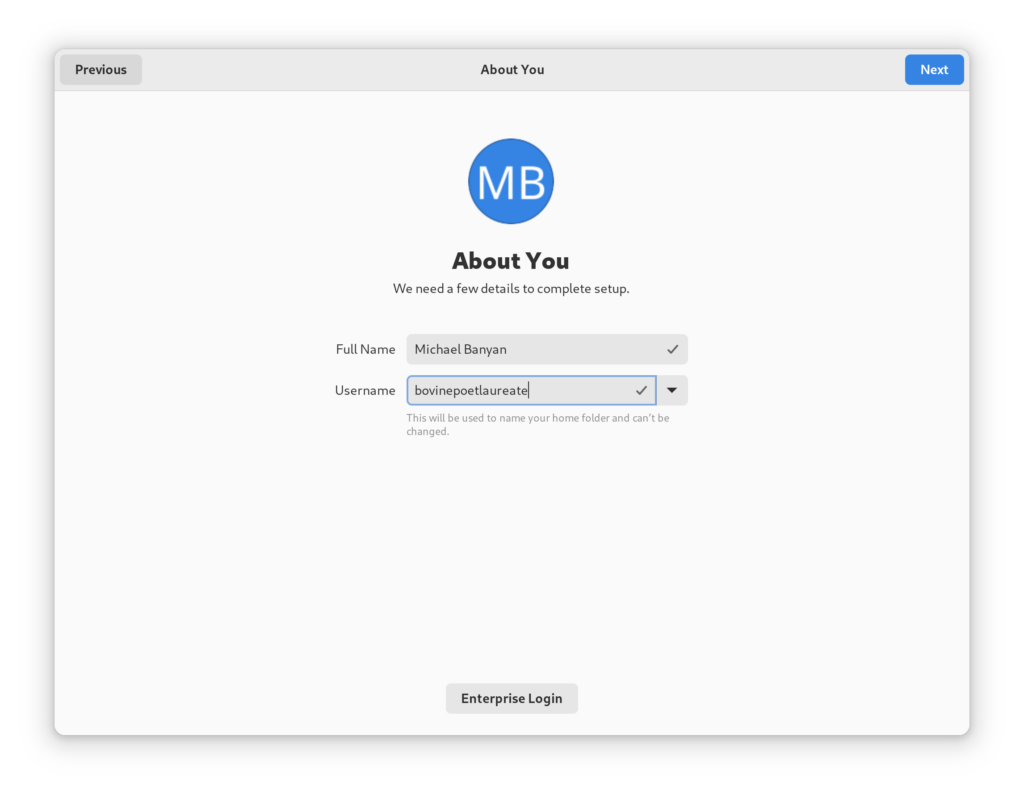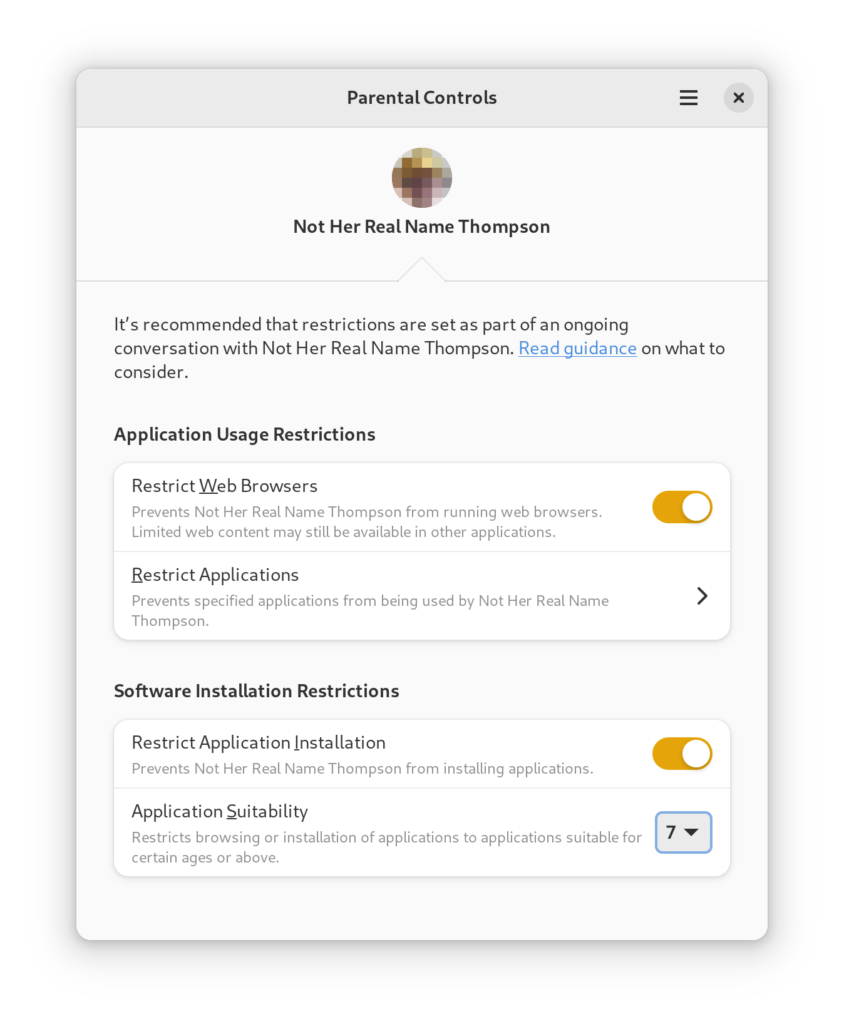GNOME 43 is out, and as always there is lots of good stuff in there. (Me circa 2014 would be delighted to see the continuous improvements in GNOME’s built-in RDP support.) During this cycle, the OS team at Endless OS Foundation spent a big chunk of our time on other initiatives, such as bringing Endless Key to more platforms and supporting the Endless Laptop programme. Even so, we made some notable contributions to this GNOME release. Here are a few of them!
App grid pagination improvements
The Endless OS desktop looks a bit different to GNOME, most notably in that the app grid lives on the wallpaper, not behind it. But once you’re at the app grid, it behaves the same in both desktops. Endless OS computers typically have hundreds of apps installed, so it’s normal to have 2, 3, or more pages of apps.
We’ve learned from Endless OS users and partners that the row of dots at the bottom of the grid did not provide enough of a clue that there are more pages than the first. And when given a hint that more pages are available, indicated by those dots, users rarely discovered that they can switch with the scroll wheel or a swipe: they would instead click on those tiny dots. Tricky even for an accomplished mouse user!
GNOME 40 introduced an effect where moving the mouse to the edges of the screen would cause successive pages of apps to “peek” in. As we’ve carried out user testing on our GNOME 41-based development branch (more on this another time) we found that this was not enough: if you don’t know the other pages are there, there’s no reason to deliberately move your mouse pointer to the empty space at the edges of the screen.
So, we proposed for GNOME something similar to what we designed and shipped in Endless OS 4: always-visible pagination arrows. What we ended up implementing & shipping in GNOME 43 is a bit different to what we’d proposed, after several rounds of iteration with the GNOME design team, and I think it’s even better for it. Implementing this was also an opportunity to fix up many existing bugs in the grid, particularly when dragging and dropping between pages.
GNOME Software
43% of the code-changing commits between GNOME Software 42.0 and the tip of gnome-software main as of 29th September came from Endless – not bad, but still no match for Red Hat’s Milan Crha, who single-handedly wrote 46% of the commits in that range! (Counting commits is a crude measure, and excluding translation updates and merge commits overlooks significant, essential work; even with those caveats, I still think the number is striking.)
Many of our contributions in this cycle were part of the ongoing threading rework that Philip Withnall spoke about at GUADEC 2022, with the goals of improving performance, reducing memory usage, and eliminating hangs due to thread-pool exhaustion. Along the way, this included some improvements to the way that featured and Editor’s Choice apps are retrieved.
Several patches bearing Joaquim Rocha’s name and an Endless email address landed in this cycle, improving Software’s handling of apps queued for installation, despite Joaquim having moved on from Endless 3 years ago. These originally come from Endless’s fork of GNOME Software and date back to 2018, and made their way upstream as part of our quest to converge our fork with upstream. In related news, we recently rebased the Endless OS branch of Software onto the gnome-43; we are down from 200+ patches a few years ago to 19. Nearly there!
At the start of this year, Phaedrus Leeds was contracted by the GNOME Foundation (funded by Endless Network) to reintroduce the ability to install and manage web apps with Software, even when GNOME Web is installed with Flatpak. This work was not quite ready for the GNOME 42 feature freeze, and landed in GNOME 43. I personally did a trivial amount of work to enable this feature in GNOME OS and add a few sites to the curated list, but as I write this post I have realised that these additions were not actually shipped in the GNOME Software 43.0 tarball. I did a bit of research into how we can expand this curated list without creating a tonne of extra work for our community of volunteers, but haven’t had a chance to write this up just yet.
Looking to the future, Georges Stavracas has recently spent some time improving Software’s sysprof integration to help understand where Software is spending its time, and hence improve its perceived responsiveness. One of the first discoveries is that the majority of the delay before a category page becomes responsive is spent downloading app icons; making this asynchronous will make Software feel much snappier. Alas, the current approach for fixing this will change Software’s plugin API, so will have to wait for GNOME 44. I’m sure that with decent profiler integration and enough eyes on the profiler, we’ll be able to find more cases like this.
GTK 4-flavoured Initial Setup
Serial GTK 4 porter Georges Stavracas ported Initial Setup to GTK 4. Since Initial Setup uses libmalcontent-ui to implement its parental controls pages, he also ported the Parental Controls app to GTK 4.
This port was a direct update of the existing UI to a new toolkit version, only adopting new widgets like GtkPasswordEntry and AdwPreferencesPage where it was trivial to do so. Designs exist for a refreshed Initial Setup interface – anyone interested in picking this up?
Initial Setup has a remarkably large dependency graph, which made this update trickier than it might otherwise have been. I made a start back in January for GNOME 42 and dealt with some of the easier library changes, but more traps awaited:
- Initial Setup depends on goa-backend-1.0, the bit of GNOME Online Accounts that actually has a user interface (which uses WebKit). This is, for now, GTK 3 only. The solution Georges used here was the same as he used in GNOME Settings: move it into a separate process.
- Next up, Initial Setup itself uses WebKit (to show the Mozilla Location Service terms of service and abrt privacy policy). The GTK 4 port of WebKit was not widely available in distros at the time of the port. As a result, Initial Setup’s GitLab CI switched from Fedora to Arch. It also means that Initial Setup has a transitive dependency on libsoup 3…
- Malcontent uses libflatpak; until recently, libflatpak had a hard dependency on libsoup 2.4 with no libsoup 3 port in evidence. So Initial Setup would transitively link to both libsoup 2.4 and 3, and abort on startup, if parental controls were enabled. Happily, a libcurl backend appeared in libflatpak 1.14, and libostree already had a libcurl backend, so if your distro configures both of those to use libcurl then parental controls can be safely enabled in Initial Setup 43.
It’s interesting to me that libsoup’s API changes have caused several GNOME-adjacent projects not to migrate to the new API, but to de-facto move away from libsoup. Hindsight is 20/20, etc. There is a draft pull request to build ostree against libsoup 3, so perhaps they will return to the soup tureen in due course.
Behind the scenes / friends of GNOME
Not all heroes wear capes, and not all contributions are as visible as others. Our team continues to co-maintain countless GNOME and GNOME-adjacent modules, and fix tricky problems at their source, such as this file-descriptor leak Georges caught in libostree.
We’ve been involved in GNOME design discussions, with Cassidy James Blaede (who joined Endless earlier this year) joining the Design team. We helped reach consensus for the new Quick Settings design, and are continuing to be involved in future design initiatives.
Someone recently asked Cassidy on Twitter whether it is true that GNOME OS is “basically just a modified version of Endless OS”, as they had heard. It’s not! But you could probably consider them second cousins once removed, and they have enough in common that improvements flow both ways. GNOME OS uses eos-updater, our libostree-based daemon that downloads and installs OS updates (and does some other stuff that GNOME OS doesn’t use). A while back, Dan Nicholson taught eos-updater how to not lose changes in /etc in the time between an update being installed, and it being booted. (Which can be pretty bad! Entire users can be lost this way!) But we found that this libostree feature interacted poorly with the way /boot is automounted on systems that use systemd-boot, so the change was disabled on such systems. More recently, Dan fixed libostree to work correctly in this case, so eos-updater can now correctly preserve changes in /etc. GNOME OS uses systemd-boot, so in due course the fixed libostree and eos-updater will appear there and this problem you probably didn’t know you have will be fixed.
And since my last post, Jian-Hong Pan updated TurtleBlocks on Flathub to the GNOME 42 runtime, dealing with another of the long tail of Flathub apps on end-of-lifed runtime versions. Sadly it fails to build on the GNOME 43 runtime due to an apparent setuptools regression, but 42 has another 6 months in it yet.
I could go on, and I’m sure I’ve there are things my fickle memory has overlooked, but for now: onwards!

